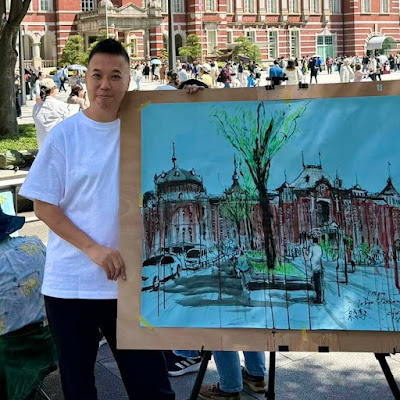Let’s Draw Kibe – A Rural Sketch Walk Reportage / きべを描くーー田舎スケッチウォーク
10月16日に山口県宇部市で行われたスケッチイベントについて、現地在住・インドネシア出身のスケッチャー、ニア(ラビニア)がレポートを寄せてくれました。USkJの活動はどうしても東京都内・近郊に偏りがちなので、地方でのイベントもこうして紹介していければと思います。文章も写真も充実の記事なので、楽しんで読んでいただけたら嬉しいです。
Nia, an urban sketcher based in Yamaguchi (originally from Indonesia) contributed a report on a sketching event in Ube City, Yamaguchi. Although most USkJ activities are centered around Tokyo, we'd like to introduce events in other regions like this as well. Hope you enjoy reading!
-----------------------------
Writer: Lavinia Elysia / 翻訳・編集:Momoko T.
As a part of Ube no Sato Art Festa (Art Festa in Village of Ube), on October 16th, 2022, Ube City Northern Area Promotion Division hosted an event called Art and Handmade Festival which was held in Former Kibe Elementary School, a closed school (Haiko) in Yamaguchi Prefecture. Kibe wo Kaku, by open house inc, was one of various workshops in that event. There were two Indonesian urban sketchers leading the sketch walk, namely Setyo Nugroho and Lavinia Elysia. Setyo Nugroho is a Lecturer at the Department of Architecture, Institut Teknologi Sepuluh Nopember (Indonesia) and a Doctoral student at Hiroshima University (Japan). While Lavinia Elysia is a designer staff in open house inc, a design office in Ube City.
2022年10月16日、うべの里アートフェスタの一環として、宇部市北部地域振興課により、手作り&アートフェスタが開催されました。会場は山口県にある廃校、旧吉部(きべ)小学校です。フェスタでは様々なワークショップが行われ、その一つとして、株式会社オープンハウスがスケッチイベント[きべを描く]を主催しました。スケッチウォークを率いたのは2名のインドネシア人アーバンスケッチャー、スティオ・ヌグロホ(スラバヤ工科大学建築学講師、広島大学大学院博士課程在籍)とラビニア・エリシア(株式会社オープンハウス、デザイナー)です。
In the morning session, Setyo and Lavinia introduced themselves and Urban Sketching inside one of the classrooms. Then everyone sketched the festival that is happening in Haiko and the surrounding area. Then we had a sketch throwdown and discussion in the classroom, sharing our impressions of each other's sketches, tools and techniques.
午前の部では、教室内で、スティオとラビニアの自己紹介とアーバンスケッチの説明を行ってから、廃校と周辺地域で開催されているフェスタの様子を全員でスケッチしました。その後、スローダウンとディスカッションを教室で行い、それぞれのスケッチの印象や使用道具、技法についてシェアしました。
There is a Teacher's Room Café inside the school building. It was full of guests, so while waiting for lunch we visited a nearby old Odana tunnel, learned a history and sketched it.
廃校内には職員室カフェがありますが、訪問客でいっぱいだったため、ランチを待つ間に大棚トンネルを訪れました。そこで歴史について学び、スケッチしました。
In the afternoon, we got one more participant and some kids came. As some sketches were left in the classroom for display, some kids were stimulated to sketch playfully inside the classroom. We explored the area of Kibe and each sketcher chose different perspectives, such as panorama of the rice field, shrine, town view, and closed buildings’ remains. After about one hour, we all returned to the classroom for discussion and took a group photo in the school yard.
午後の部では、参加者が一名増え、子どもたちも何人か加わりました。教室内にいくつかスケッチが飾られていたので、子どもたちも刺激を受けて、教室内でスケッチをして遊んでいたようです。わたしたちは吉部エリアを探索し、それぞれ異なる地点からスケッチしました(田んぼのパノラマ風景、神社、町の景色、廃屋の跡地など)。約1時間後、教室に戻ってディスカッションを行い、校庭で集合写真を撮りました。
One of the staff of Ube City Northern General Branch mentioned, “It was great to see the Kibe area sketched in such different styles and perspectives. Some of the sketches make me remember the lively era of Kibe town”.
オープンハウスの代表取締役、益田文和氏は以下のようなコメントを寄せています。「こうしたスケッチ活動は、日本国内、とりわけ山口では、まだ新しいものですが、身近な環境の価値を気づかせてくれる、とても良い機会だと思います。人々は日々の環境に慣れすぎていて、実際にスケッチし、他の人の視点と合わせてシェアするまで、その美しさに気づかないこともあるのです」。
宇部市北部総合支所のスタッフの方からは、「様々なスタイルと視点で描かれた吉部を見ることができて素晴らしかった。スケッチを見ていると昔まだ賑やかだった時代の吉部が思い出されるようだ」との感想が寄せられました。
One participant was actually an urban sketcher from neighboring Yamaguchi City, and another one was a local animator from Sanyoonoda City. We were glad to find out about each other. It was a small yet fruitful rural sketch walk.
参加者の一人は山口市のアーバンスケッチャー、もう一人は山陽小野田市のアニメーターでした。お会いできて嬉しかったです。小規模ながらも実りの多いスケッチウォークでした。
On the day of the event, we started sketching at 10 in front of the ex-elementary school Kibe, while another sketcher went to sketch a Jinja. In the afternoon session, we went to the area of Miyanomae, close to the Kibehachimangu. The most impressive moment was when the City government staff took us to the Odana Tunnel. The Tunnel was built during the Taisho period in 1925 to serve as a railway, but the rails were removed due to World War II in 1944. During the event, some locals were enthusiastically seeing our sketching collections. They were asking about the process of sketching, the places I sketched, daily activities, and even questions about my field of study and future dreams.
I learned a lot from others. For example, how they decide on the spot and how they bring the spot into a paper. Nia-san with her lively sketch seems to bring a vibrant image of the peaceful Kibe. Eri-san with her expression about “betsu no sekai” reminds me of the landscape theory “here and there”. Okada-san decided to use 2/3 of her paper to draw a blue sky to express the dominance of the sky in the mountainous landscape. It was a great experience and I felt so lucky to be part of the event!
スティオ・ヌグロホよりコメント
イベント当日は10時から旧吉部小学校の前でスケッチを始め、参加者の一人は神社を描きに行きました。午後の部では、吉部八幡宮近くの宮の前エリアに足を伸ばしました。最も印象深かったのは、宇部市のスタッフの方が連れて行ってくれた大棚トンネルです。大正時代の1925年に鉄道トンネルして建設されましたが、1944年に第二次世界大戦のため(鉄の供出のため)レールが撤去され廃線となりました。イベント中、地元の方々が熱心に僕らのスケッチを眺めていました。どのようにスケッチするか、どこで描くか、普段の活動や、僕の学んでいる分野や将来の夢についてまで質問されました。
他のスケッチャーからも多くを学びました。例えば、場所の決め方や、その場所をどんなふうに紙に収めるのか、といったこと。ニアさんの生き生きしたスケッチはのどかな吉部の鮮やかな姿を引き出します。えりさんの「別の世界のようだ」という言葉は、ランドスケープの理論における“here and there”(こことそこ、こちらの世界と遠くの別世界)の概念を連想させました。岡田さんは紙の2/3を使って空を描き、山並みの景色を占める空の大きさを表現していました。素晴らしい経験で、参加できたことをとても嬉しく思います!
Lavinia Elysia’s comment
I have always been living in the cities and had never spent my life in a rural area any longer than I did here in Yamaguchi Prefecture. Finally finding people with similar love of sketching here really excites me. I enjoy sketching alone, but sketching with the Urban Sketchers community is enriching. Sharing different sketches, techniques and perspectives always humbles me in seeing life. It helps me to value my daily environment more.
It feels good that a sketch can turn into a conversation with locals, especially when we do not speak the language well. Sketching in rural areas seems to bring delight to local people as well. There was one elderly man who hosted an open house as a part of the festival. He showed Setyo and I his collection of antique Japanese Yatate, a Portable Brush and Ink Holder, a tool that was used to bring around brush and ink from the Edo Era. Seems like bringing around sketching or writing tools had been a common habit of us all, human beings. For me, as a foreigner in Japan, this was truly a priceless experience. Seeing other sketcher’s happiness to find each other in this rural area was also another valuable memory. Let’s keep on sketching and sharing!
ラビニア・エリシアよりコメント
わたしはずっと都会暮らしで、ここ山口での生活よりも長く田舎に住んでいたことはありません。この土地でやっと同じようにスケッチを愛する人に出会えたことが嬉しいです。一人でのスケッチも楽しいですが、Urban Sketchersコミュニティの人たちとスケッチするのは、もっと豊かな体験です。異なるスケッチ、技法、視点をシェアすることで、より謙虚に世界を見ることができます。日々の環境をいっそう大事にできるのです。
スケッチを発端に地元の人との会話が生まれるのも、特にその土地の言葉が上手に話せないときは、嬉しいものです。田舎でのスケッチは地元の人々にとっても喜びをもたらすようです。フェスタで自宅を開放していたお年寄りの方が、スティオさんとわたしに、骨董品の矢立(江戸時代から使用されていた持ち運びできるペンとインクのセット)コレクションを見せてくれました。スケッチ道具や筆記具を持ち歩くのは、わたしたち人間すべてに共通する習慣のようです。日本に住む外国人として、これは本当に貴重な体験でした。他のスケッチャーたちがこの田舎の土地で互いに出会えた瞬間を見られたのも、素晴らしい思い出になりました。これからもスケッチし、シェアし続けましょう!



















Comments
Post a Comment